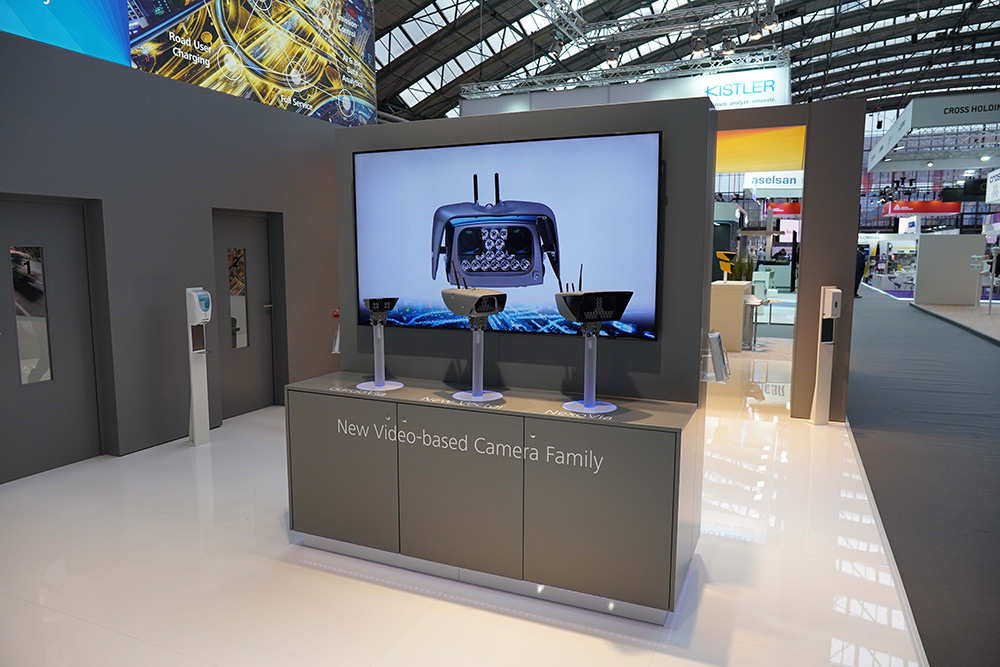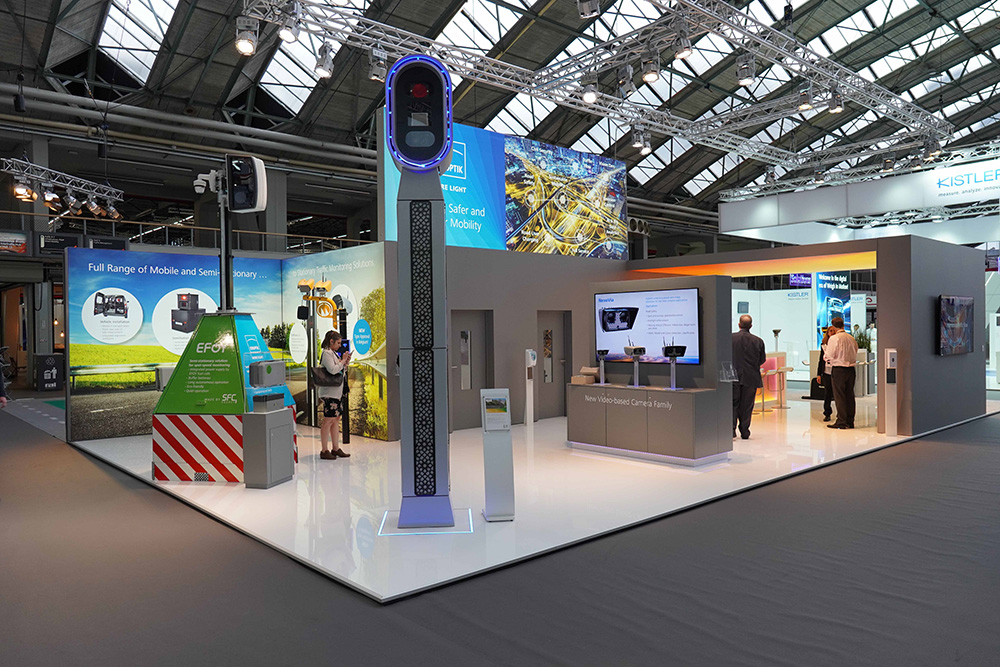
Companies across the ITS sector are presenting themselves in a quite different way to that which we would have seen a decade ago: it’s far more about outcomes and solutions, much less about technology per se. Brand messaging seems increasingly consumer-focused - for example, pictures of smiling children cycling on a road or walking to school rather than pictures of the traffic cameras which allow them to do so in safety.
Sitting down at Intertraffic Amsterdam with Dr. Stefan Traeger, CEO of optical technologies group Jenoptik, and executive vice president Kevin Chevis, who is responsible for Jenoptik’s Smart Mobility Solutions division, ITS International wondered if they had noted this shift in emphasis.
Outcomes focus

“Even four years ago, if you asked people what we did, they would probably say: ‘We do speed control, red light and we sell cameras’,” Chevis begins. “And over the last few years, it’s really clear to us that we’re much less interested in how many megapixels something is and much more interested in the outcome. We’re very proud of the fact that the technology we’ve provided for many, many years – and the foundations of our division go back almost 90 years - there are a lot of people alive today, walking today, that might not have been had we not provided that technology. So we’ve certainly realised that technology is an enabler. We’re making the road a safer place in more ways than one: it might be through speed management, or intelligence for the police – or it might be new things we’re getting involved in like moving vehicle offences or emissions control: we’ve seen some smart mobilities projects where the aim is not to manage speed, it’s to manage emissions in a dynamic way. So we’re much more interested in what the client is trying to achieve and how we help them do that. Customers now are much more switched on to the outcome rather than which cameras they’re using - because it’s become less relevant, to be honest. We invest heavily in more software, more artificial intelligence and deep learning. In terms of simple things like how well we can read a number plate - a bad number plate in a challenging place with bad weather conditions or at night - by using AI, we’ve raised the bar of what we used to think was possible. And these might be small changes, but they are significant because they do affect the outcome. So we’re much more interested in leveraging our expertise there than perhaps just selling a camera system, which 10 years ago, you’re absolutely right, we would have been focused on.”
Future of mobility
Traeger says: “I would add that, from a group perspective, of course we want to grow our business. But there’s much more to it: it’s not just about financials – we have a vision for the whole world to enable brighter futures with the power of light. One important aspect is to drive the future of mobility for society. It’s not just measuring how fast one person might be speeding down the road - it is providing a whole solution about how we as human beings get from A to B in a smarter, more sustainable way that’s better for the environment. You still want to get from A to B as fast as possible, obviously, but in a smarter way.”
This increasing awareness of the group’s role in society, through mitigating environmental impact and so on, is something Traeger is keen to stress. “Jenoptik traditionally is a very engineering-driven company,” he says. “That’s where we come from: that’s our roots, that’s our heritage - and that’s completely fine. We love that DNA of dare I say, German engineering – we love it! And we want to keep that DNA - but we also want to build on that to create a much more customer-focused, customer-centric approach to solving problems. That does mean we have to take the customers with us, we have to work with them, we have to be easy to work with. We’re not just throwing numbers and megapixels at them – but we’re showing them why it’s good to work with us.”
As well as being a shift in emphasis, this increased willingness to work with customers to solve their problems also opens up opportunities for Jenoptik in the mobility ecosystem.
Client requirements
“We’re providing more services now,” explains Chevis. “It’s less about somebody buying a piece of equipment, and then having an annual maintenance contract. It’s much more about working together to change what we do over time against a revenue-based model. And that does require partnership, because it’s not a one-off buy; so we have different service solutions now which might run over five, six, seven years, and might even be extended, based on the client requirements. We’re charging in a revenue stream - per lane, per camera, per user, per month, that type of model. So it makes it more affordable for our clients to actually get access to what we can do. Also, we run back-office software systems in the cloud, as Software as a Service. And we’ve seen more integrated solutions: with the platforms we have, you can run speed management, you can do emissions control, you can do surveillance, you can do all sorts of things – and you can scale up, you can scale it down. Being dynamic like that is important: even through the day, our clients want to achieve different things. So the systems are super flexible.”

For companies looking at the balance sheet, one particularly attractive element of SaaS is the consistent revenue stream it provides.
“It’s no secret we’re proactively looking to increase the percentage of long-term, stable, recurring revenues,” smiles Chevis. “And it’s also good because when you’re working in a partnership like that, you are involved in what’s happening. Increasingly, we have much closer relationships with the policy and decision makers in the client base - not just the people who buy the technology - because they’re trying to achieve an objective. We’ll be much more consultative today and offer ideas and maybe trial things within that service, so we’re giving more value and I think clients can get more done, more quickly. And they can do so with more confidence; if we have a long-term relationship then we have to get a better understanding – which is why I think we’re talking about outcomes, because we actually need to understand what they truly want to achieve. And then we have to say: ‘Well, this is how maybe we can support you with that’.”
High integrity
Even with the best of intentions, it is not necessarily possible to help every customer – and perhaps recognising this is an important part of being a responsible service provider.
“We do have discussions about that,” Chevis says. “And there are times where specifications might be just too demanding. We are an organisation that delivers and has high integrity. So if we take a contract on that’s challenging, then we’ll actually talk to the client and explain that they may have to accept that they might need to adjust something - but let’s be open and honest about what’s possible, and not possible. So there are times we say no, that’s for sure. But not so many, because as I said earlier we’re trying to differentiate by pushing the boundaries of what used to be possible, so we can operate with tighter tolerances, higher performance rates and so on. But some clients do have demanding requirements when you look at them, and you say ‘that’s not for us, we can’t do it’. And it’s always tough to walk away but that’s the right decision sometimes. We want a satisfied client base and we believe we have a good reputation. We want to enhance that, not to degrade it in any way. So again, it’s about honesty and openness: that’s a fundamental part of our culture – open, driving, confident - to have those discussions with clients and say ‘Are you really sure you want to do it like this?’”
Jenoptik has its eye on a couple of future mobility solutions where it might make a mark.

“I would reference a couple of technology trends,” Traeger explains. “As a company overall, across all businesses, we see a drive for what we call ‘extended reality’ - virtual reality, augmented reality. And now you might ask, what does a device like Google Glass have to do with mobility? I believe a lot, actually, because the AI solutions that you need for the software for that is applicable to Kevin’s business, big time. The deep-learning algorithms that we use to do automatic number plate recognition can be also used to spot, for example, errors made in a production process in a steel plant or machine shop someplace else. That fundamental technology has a lot to do with software and image analysis and, basically, the interface between the digital world and the human being. We are used to dealing with analogue processes but Covid has acted as a catalyst to an ever-more digital era. This digitisation of our world is going to a completely different level – and I’m sure that also applies to the mobility sector.”
AI and VR
Making use of AI at a high level is tough though, says Chevis. “It requires a specialised group of people to achieve that to the levels we need for homologated systems and high performance. But you see that fusion with radar, laser, Lidar and video is where we’re heading. Because when you’ve got the right platform to do that, and you got the right expertise, then many things are possible.”
These mentions of AI and augmented reality point to a company with more than half an eye on future challenges and opportunities. “We often talk about Big Data,” Chevis continues. “Well, our infrastructure collects data and we can do many things with that, so we’re looking to leverage that much more than we used to. And a lot of our clients have a realisation that this is here and you actually can get some benefit now and get a plan for the future as well. So we’re using all that to position ourselves for the longer-term future of autonomous vehicles and what that really means.”
What it means for Jenoptik is to leverage its expertise in infrastructure and location accuracy. “Because that’s core to what we’re really good at: measurement. And you would never have described us like that years ago because you’d have talked about cabinets,” he laughs. “But it’s a deliberate focus on accuracy, repeatability, and consistency in measurement - and then the application of that data we can adapt in AI, video and so on, and using that to have an outcome that makes something better for our clients. That’s pretty much what we’re about. And even as a company, it takes time to understand that yourself; we’re redrawing how we describe ourselves because things move fast.”
TraffiPole: an Intertraffic Awards winner
Jenoptik won the Intertraffic Green Globe Award 2022 for its TraffiPole traffic cabinet, whose innovative design enables ITS hardware to function in hot climates without the need for air conditioning, thus reducing energy consumption and CO2 emissions.
While the environmental consciousness on display here – using recycled aluminium, for example – is admirable, it is unusual for a company to put so much effort into the design. It seems to echo Apple’s philosophy of starting with the design and working backwards from there.
 Traffic cabinets don’t need to be attractive – and yet TraffiPole is. “It’s interesting that you mention Apple, because a number of years ago when we first developed the concept of our Vector camera family range, we wanted it to not look like a traditional camera,” explains Jenoptik’s Kevin Chevis.
Traffic cabinets don’t need to be attractive – and yet TraffiPole is. “It’s interesting that you mention Apple, because a number of years ago when we first developed the concept of our Vector camera family range, we wanted it to not look like a traditional camera,” explains Jenoptik’s Kevin Chevis.
“So we put quite a lot of effort into making it as compact as possible, but also aesthetically pleasing. So the whole design has changed, and the shrouding we put on the casing around it has a much more modern look and feel. So it was about performance and capability, but we also said ‘People like Apple phones, they like the way they feel, the way they operate’ - so we wanted to make it better. We also picked up in a number of our clients that they were very worried about street furniture: how much there is, how ugly it looks, and so on. So for many of our designs now we have somebody in our team who is focused on ‘well what’s it going to look like? Are we going to be proud to say that’s ours?’
With TraffiPole we said: ‘Can we do this with recycled material? Can we do this without air conditioning in a hot country?’ It’s quite a challenge but there was some great technology and ideas that went into it, but it also needed to look good, to match the surroundings. It was great to win the award, it was a culmination of quite a lot of the team’s efforts.”





